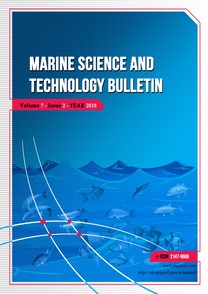The blue crab (Callinectes sapidus, Rathbun, 1896) is spreading in the southern coast of the Black Sea
The blue crab (Callinectes sapidus, Rathbun, 1896) is spreading in the southern coast of the Black Sea
___
- Ak, O., Haşimoğlu, A. & Bayram, K. (2015). South eastward expansion of the blue crab Callinectes sapidus (Rathbun, 1896) in the Black Sea. Cahiers de Biologie Marine, 56: 397-399.
- Ayas, D. & Özoğul, Y. (2011). The effects of sex and seasonality on the metal levels of different muscle tissues of mature Atlantic blue crabs (Callinectes sapidus) in Mersin Bay, north-eastern Mediterranean. International Journal of Food Science & Technology, 46: 2030-2034.
- Aydın, M. (2017). First record of blue crab Callinectes sapidus (Rathbun 1896) from the middle Black Sea coast. Turkish Journal of Maritime and Marine Sciences, 3(2): 121-124.
- IMO. (2002). 1st Black Sea Conference on Ballast Water Control and Management, Odessa, Ukraine, 10-12 October 2001: Conference Report. GloBallast Monograph Series No. 3. London, UK.
- Bulgurkov, K. (1968). Callinectes sapidus Rathbum (CrustaceaDecapoda) in the Black Sea. Izvestiya Nauchnoizsled Rybno Stop Varna, 9: 33–36.
- Castriota, L., Andaloro, F., Costantini, R. & De Ascentiis, A. (2012). First record of the Atlantic crab Callinectes sapidus Rathbun, 1896 (Crustacea: Brachyura: Portunidae) in Abruzzi waters, central Adriatic Sea. Acta Adriatica, 53(3): 467-471.
- Enzenroß, R., Enzenroß, L. & Bingel, F. (1997). Occurrence of blue crab, Callinectes sapidus (Rathbun, 1896) (Crustacea, Brachyura) on the Turkish Mediterranean and the adjacent Aegean coast and its size distribution in the bay of Iskenderun. Turkish Journal of Zoology, 21: 113-122.
- Diripasko, O. A., Izergin, L. V. & Koshkalda, A. I. (2009). First finds of the blue crab Callinectes sapidus (Portunidae, Decapoda) in the Sea of Azov. Vestnik Zoologii, 43(6): 529–532.
- Khvorov, S. A. (2010) Decapods (Decapoda), in Vselentsy v bioraz-noobrazii i produktivnosti Azovskogo i Chernogo morei (Invaders in Biodiversity and Productivity of the Sea of Azov and Black Sea), Matishov, G. G. and Boltachev, A. R. (Eds.), Rostov-onDon: Izd YuNTs RAN: 70–75.
- Mancinelli, G., Chainho, P., Cilenti, L., Falcod, S., Kapiris, K., Katselis, G. & Ribeiro, F. (2017). The Atlantic blue crab Callinectes sapidus in southern European coastal waters: Distribution, impact and prospective invasion management strategies. Marine Pollution Bulletin, 11: 5- 11.
- Monin, V. L. (1984). New find of the blue brab Callinectes sapidus (Decapoda, Brachyura) in the Black Sea. Zoologicheskii Zhurnal, 63(7): 1100–1101.
- Nehring, S. (2011). Invasion history and success of the American blue crab Callinectes sapidus in European and adjacent waters (pp. 607-624). In: Galil, B. S., Clark, P. F., Carlton, J. T. (Eds.), The Wrong Place Alien Marine Crustaceans: Distribution. Biology and Impacts, Netherlands: Springer.
- Pashkov, A. N., Reshetnikov, S. R. & Bondarev, K. B. (2012). The capture of the blue crab (Callinectes sapidus, decapoda, crustacea) in the Russian sector of the Black sea. Russian Journal of Biological Invasions, 3(1): 22-28.
- Sağlam, N. E., Kesici, U. Y. & Akdoğan, P. (2011). Some invasive species in the Black sea and their effects on the Black sea ecosystem. Eğirdir Su Ürünleri Fakültesi Dergisi, 7(1): 25-38.
- Shefer, S., Abelson, A., Mokady, O. & Geffen, E. (2004). Red to Mediterranean Sea bioinvasion: Natural drift through the Suez Canal, or anthropogenic transport? Molecular Ecology, 13: 2333-2343.
- Sharov, A. F., Vølstad, J. H., Davis, G. R., Davis, B. K., Lipcius, R. N. & Montane, M. M. (2003). Abundance and exploitation rate of the blue crab (Callinectes sapidus) in Chesapeake Bay. Bulletin of Marine Science, 72(2): 543– 565.
- Shaverdashvili, R. S. & Ninua, N. Sh. (1975). New find of crab Callinectes sapidus Rathbun, 1896 in the Black Sea. Nauchnye Doklady Vysshei Shkoly, Biologicheskie Nauk. 9: 19-20.
- Şahin, C., Emiral, H., Okumuş, I., Gözler, A. M., Kalaycı, F. & Hacımurtezaoğlu, N. (2009). The benthic exotic species of the Black sea: blood cockle (Anadara inaequivalvis, Bruguiere, 1789: Bivalve) and rapa whelk (Rapana thomasiana, Crosse, 1861: Mollusc). Journal of Animal and Veterinary Advances, 8(2): 240-245.
- Turan, C., Erguden, D. & Gürlek, M. (2016). Climate change and biodiversity effects in Turkish seas. Natural and Engineering Sciences, 1(2): 15-24.
- Williams, A. B. (1974). The swimming crabs of the genus Callinectes (Decapoda: Portunidae). Fishery Bulletin, 71(3): 685-692.
- Yağlıoğlu, D., Turan, C. & Öğreden, T. (2014). First records of blue crab Callinectes sapidus (Rathbun 1896) (Crusteacea, Brachyura, Portunidae) from the Turkish Black Sea coast. Journal of Black Sea/Mediterranean Enviroment, 6(1): 13-17.
- Zaitsev, Y. (1998). Samoe sinee v mire (Most Blue in the World). Izd OON, New York, USA. 142p.
- Zenetos, A., Çinar, M. E., Pancucci-Papadopoulou, M. A., Harmelin, J. G., Furnari, G., Andaloro, F., Bellou, N., Streftaris, N. & Zibrowius, H. (2005). Annotated list of marine alien species in the Mediterranean with records of the worst invasive species. Mediterranean Marine Science, 6: 63-118.
- ISSN: 2147-9666
- Yayın Aralığı: 4
- Başlangıç: 2012
- Yayıncı: Adem Yavuz SÖNMEZ
Quratulan AHMED, Semra BENZER, Qadeer Mohammad ALİ
Mahinur KIRICI, Muhammed ATAMANALP, Muammer KIRICI, Şükrü BEYDEMİR
Sabri Bilgin, Quratulan Ahmed, Qadeer Mohammad Ali
Muammer KIRICI, Muhammed ATAMANALP, Mahinur KIRICI, Şükrü BEYDEMİR
Mustafa Karga, Soner Bilen, Yasemin Celik Altunoglu, Ferhat Ulu, Gouranga Biswas
